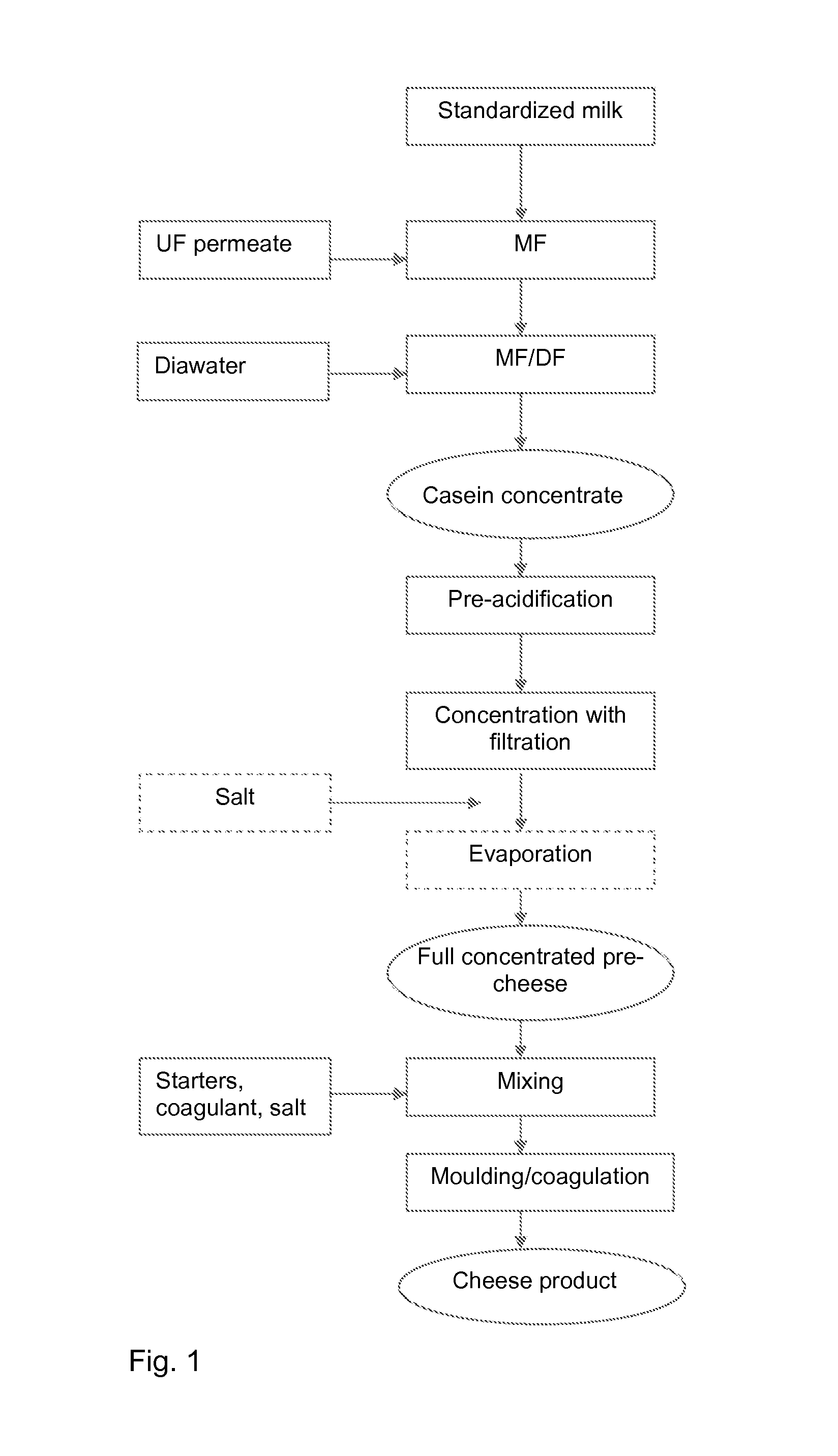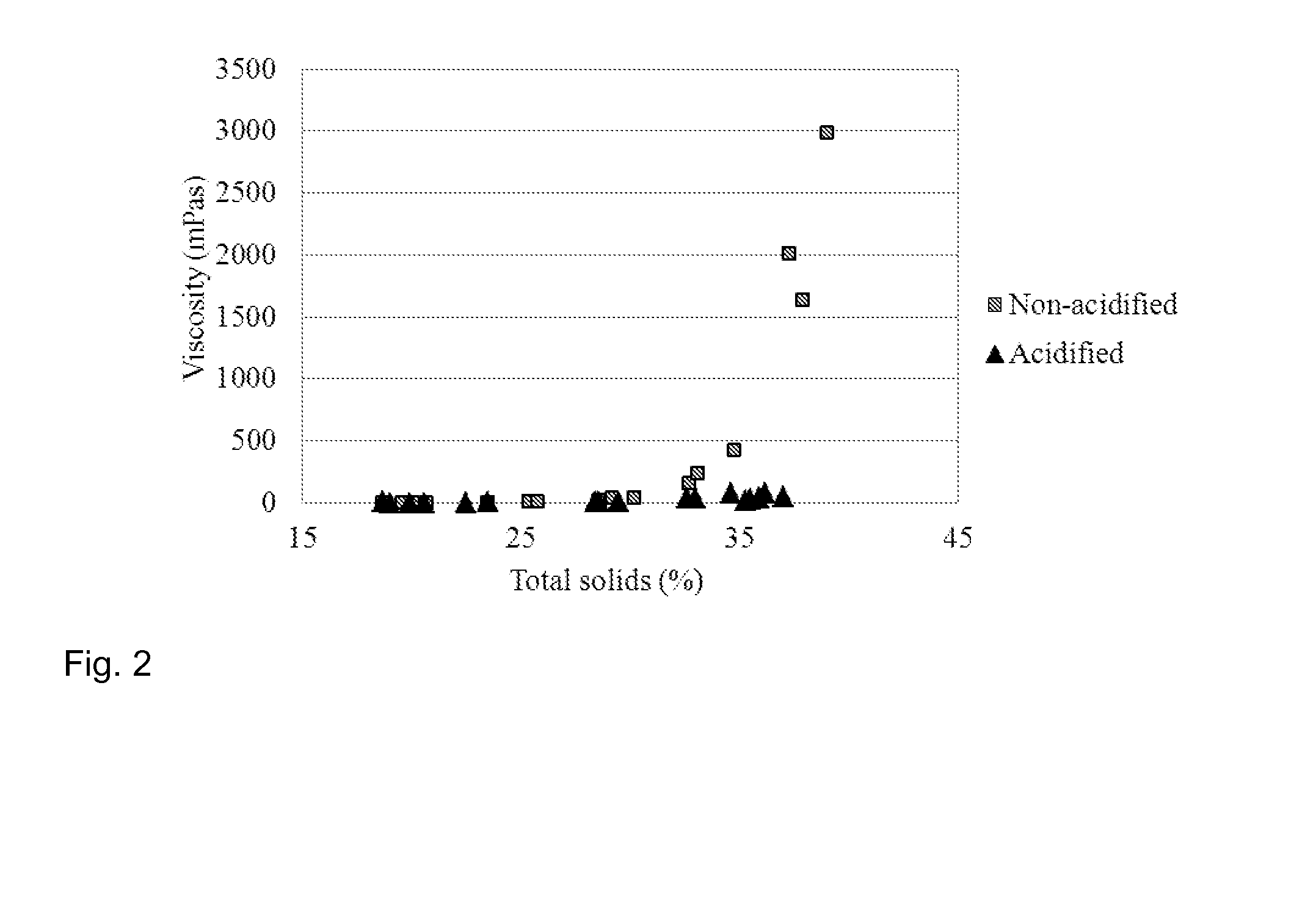Cheese and preparing the same
- Summary
- Abstract
- Description
- Claims
- Application Information
AI Technical Summary
Benefits of technology
Problems solved by technology
Method used
Image
Examples
example 1
[0058]Raw milk was partially-skimmed and the fat-protein ratio was standardized to a desired ratio typical for each cheese type prepared in Examples 1.1, 1.2. and 1.3 below. The standardized raw milk was pasteurized at 72° C. for 15 s. Microfiltration was carried out by concentrating the standardized and pasteurized milk at 50° C. by recirculating the milk through spiral-wound membranes with an 800-kDa molecular cutoff membrane. The feeding pressure of the raw milk was 40 kPa and the pressure difference was 80 kPa over the membrane.
[0059]Milk was concentrated by microfiltration to concentration factor 4 before diafiltration. Two separate diafiltration steps were then used. The first diafiltration was performed by using 1.6-fold, based on the used amount of the feed, ultrafiltration permeate obtained from ultrafiltration of a microfiltration permeate of the milk. The second diafiltration step was performed by using 0.28-fold brine (0.5% w / v NaCl) based on the used amount of the feed....
example 1.1 (
Concentration with Filtration, No Evaporation)
[0061]The acidified retentate obtained from Example 1 was heated to the filtration temperature (50° C.) prior to concentrating it with microfiltration. The microfiltration was performed with a ceramic microfiltration membrane with molecular cutoff of 0.1 μm to provide full concentrated pre-cheese as a microfiltration retentate. Microfiltration was performed at 50° C. by recirculating the retentate through membrane and permeate through permeate site of membrane. Uniform transmembrane pressure (TMP) was 70 kPa. The feed was concentrated to concentration factor 2.
[0062]The composition of the initial feed, i.e. standardized milk, the casein concentrate and the full concentrated pre-cheese are shown in Table 2.
TABLE 2Concentration withmicrofiltration,no evaporationFullconcentratedRetentateNon-pre-cheesefrom Ex. 1acidified(invention)Standardized(caseinreferencepre-acidifiedmilkconcentrate)(pH 6.6)(pH 5.75)Total solids (%)16.536.051.851.8Fat (%...
example 1.2 (
Concentration with Filtration and Evaporation)
[0065]The acidified retentate obtained from Example 1 was heated to the filtration temperature (50° C.) prior to concentrating it with microfiltration. The microfiltration was performed with a ceramic microfiltration membrane with molecular cutoff of 0.1 μm. The microfiltration was performed at 50° C. by recirculating the retentate through membrane and permeate through permeate site of membrane. Uniform transmembrane pressure (TMP) was 70 kPa. The feed was concentrated to concentration factor 2.
[0066]After microfiltration, salt was added to the microfiltration retentate. The retentate was then evaporated at 70° C. and at 1 bar vacuum by using a Stephan-vat to provide full concentrated pre-cheese as a microfiltration retentate.
[0067]The composition of the initial feed, i.e. standardized milk, the casein concentrate and the full concentrated pre-cheeses (after concentration with microfiltration, and after concentration with microfiltration...
PUM
 Login to View More
Login to View More Abstract
Description
Claims
Application Information
 Login to View More
Login to View More - R&D
- Intellectual Property
- Life Sciences
- Materials
- Tech Scout
- Unparalleled Data Quality
- Higher Quality Content
- 60% Fewer Hallucinations
Browse by: Latest US Patents, China's latest patents, Technical Efficacy Thesaurus, Application Domain, Technology Topic, Popular Technical Reports.
© 2025 PatSnap. All rights reserved.Legal|Privacy policy|Modern Slavery Act Transparency Statement|Sitemap|About US| Contact US: help@patsnap.com


